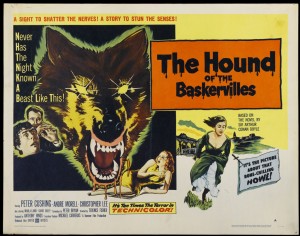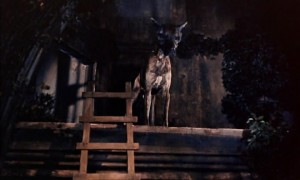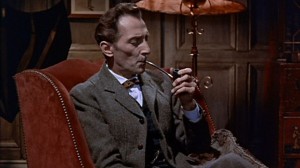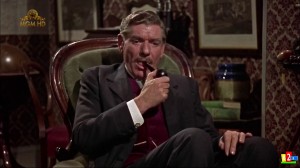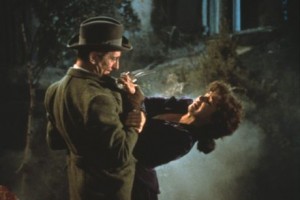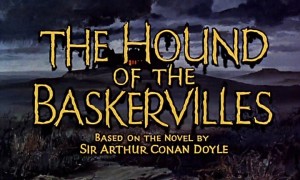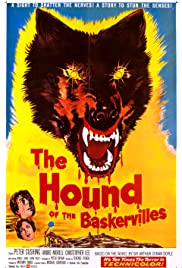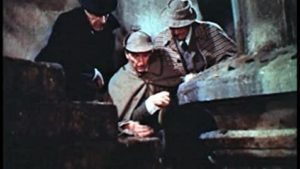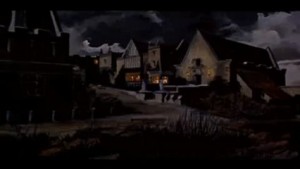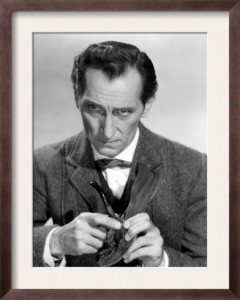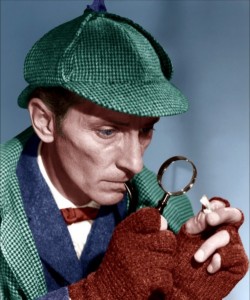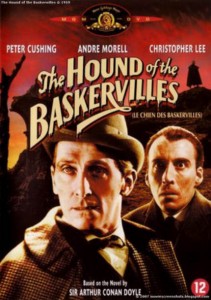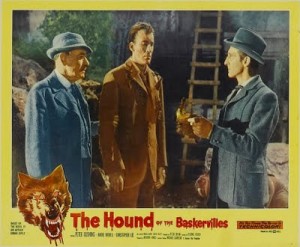The Hound of the Baskervilles **** (1959, Peter Cushing, André Morell, Christopher Lee) – Classic Movie Review 313
‘It’s the picture about that bone-chilling HOWL!’
Director Terence Fisher’s 1959 vintage horror mystery The Hound of the Baskervilles is based on the novel by Sir Arthur Conan Doyle, and stars Peter Cushing as Sherlock Holmes, André Morell as Doctor Watson and Christopher Lee as Sir Henry Baskerville.
Hammer Films’ notable 1959 version of Sir Arthur Conan Doyle’s classic story is smart, beautifully performed and quite commanding. It is important and deserves special attention as the only Holmes film made by Hammer Films and as Sherlock Holmes’s first screen appearance in colour (Technicolor).
Peter Cushing and André Morell are on excellent form as Sherlock Holmes and Dr Watson, who set about to investigate the perils in store for the latest Baskerville heir, Sir Henry (Christopher Lee) and the mystery of the supernatural hound apparently taking revenge on the Baskerville family. After his predecessor is murdered, Sir Henry has recently returned from service in the British colonies to assume his title, and takes up residence in the Baskerville manor house on the lonely moors.
The original story is a gift to any screenwriter, but Peter Bryan provides an intelligent script that offers an atmosphere of useful darkness and some subtleties and ambiguities in the characters and plotting. Broadly the plot of the movie is very similar to the plot of the novel, though Doyle’s many subplots and false trails are dropped.
In a film that successfully segues from horror to thriller to comedy and back, director Terence Fisher conjures up the right eerie mood, enormously helped by the performances, the surprisingly classy production with set designs by Bernard Robinson, and the beautifully achieved, still vibrant looking Technicolor cinematography by Jack Asher.
The story opens with a flashback as told by Doctor Mortimer (Francis De Wolff) to Holmes, hiring him to protect Sir Henry, in which the story of the wicked Sir Hugo Baskerville (David Oxley) is outlined in typical Hammer horror fashion. Cushing’s grave, waspish, quick-witted and fleet-footed Holmes soon disappears for a while, giving Watson more to do than usual. And, happily, he is treated seriously and expertly by Morell, in a way quite unlike the usual buffoon he is often portrayed as.
Meanwhile Lee battles a rather passive part with his customary grave dignity and Miles Malleson provides effective comic relief as the Bishop who, improbably, breeds dangerous tarantulas.
Marla Landi and Ewen Solon are suitably ripe in exotic roles as ambiguously portrayed neighbours, the Stapletons. And there is room for John le Mesurier (Barrymore), Sam Kydd (Perkins), Helen Goss (Mrs Barrymore), Michael Hawkins (Lord Caphill), Judi Moyens (Servant Girl), Michael Mulcaster (Convict), and David Birks (Servant) too.
Surprisingly, maybe, this fondly remembered movie stands up very well compared with other versions of The Hound of the Baskervilles and with Hammer’s general output.
It is shot at Bray Studios, Down Place, Oakley Green, Berkshire, England, as well as at Frensham Ponds, Farnham, Surrey, England, and Chobham Common, Surrey, England.
The running time is
Hammer planned a series of Sherlock Holmes with Peter Cushing in the starring role, but the idea was scrapped because The Hound of the Baskervilles was weaker at the box office than Hammer’s monster and vampire films. However, Cushing reprised his role as Sherlock Holmes in Sherlock Holmes (1964) and The Masks of Death (1984). And Lee starred in six Conan Doyle filmed adaptations: The Hound of the Baskervilles (1959), Sherlock Holmes and the Deadly Necklace (1962), The Private Life of Sherlock Holmes (1970), Sherlock Holmes and the Leading Lady (1991), Sherlock Holmes: Incident at Victoria Falls (1992) and Orson Welles’ Great Mysteries (1973).
Cushing didn’t enjoy Holmes’s pipe and kept a glass of milk handy on set to remove the taste. Meanwhile Lee had a morbid fear of spiders, and the panic on his face in the scene with the tarantula was real.
The other versions of The Hound of the Baskervilles: include most notably The Hound of the Baskervilles (1939).
Peter Cushing and Christopher Lee made approximately 25 films together.
Baskerville Hall redresses the set for Castle Dracula in Lee and Cushing’s Dracula (1958).
Costs prevented going ahead with the original plans for animation techniques for the hound, so in the end the hound was a real dog called Colonel. They could not get Colonel to jump on Lee to attack him, so they started to prod him into action and suddenly Colonel lunged on him and bit him hard in his arm. Crew member Margaret Robinson had to create a frightening mask for the dog to wear: ‘I made the mask out of rabbit fur, and the dog wouldn’t allow anyone else to put the mask on him. He was a lovely dog, to me at least.’
In the still censored version for the UK, the scene where Sir Hugo Baskerville pushes a servant into a burning fireplace remains trimmed of a few seconds. Also the scene where the a peasant girl is caught and murdered by Sir Hugo remains shortened in censorship cuts.
Cushing painstakingly researched his role and even provided his own costumes, and often made amendments to his dialogue. He got the mantlepiece to feature Holmes’s correspondence transfixed to it with a jackknife as in the original stories.
http://derekwinnert.com/the-hound-of-the-baskervilles-1939-classic-film-review-314/
© Derek Winnert 2013 Classic Movie Review 313
Check out more reviews on http://derekwinnert.com

